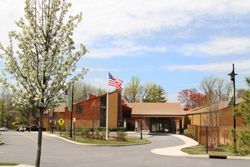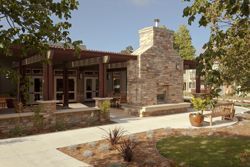In an earlier article, I highlighted the trend of retirement communities adopting green practices. Atria Senior Living is one senior living provider who has not only embraced green-building methods but are putting these practices front and center for residents and their families to see.

Atria on the Hudson is the only LEED certified retirement community in Westchester County.
A data screen that displays up-to-minute electricity savings and native drought-tolerate landscaping that prompts requests for the landscaper’s number: these are just a few of the community highlights that family and friends are surprised to see when visiting the Atria on the Hudson and Atria Valley View communities. These additions aren’t just novelties but are a number of features that will eventually become commonplace at other Atria communities across the United States.
“Let’s be honest, it’s not easy being green, but it’s worth it,” says Stephen Nichols, executive director of Atria on the Hudson in Ossining, New York. As the only green community in Westchester County, this LEED Silver certified community is a draw for seniors seeking environmentally friendly living. The community was designed from the ground up with sustainability in mind, and Nichols says this is apparent to visitors and residents since the closest parking spots are reserved for green vehicles and automatic lighting is used.
 Atria on the Hudson is one of three Atria communities that now have solar panels, and while the popular reason for solar panels is reducing electricity consumption, there is another benefit that surprised Nichols. During Superstorm Sandy, we only lost power for a short time, and I never once thought of solar panels providing a safety benefit, he says.
Atria on the Hudson is one of three Atria communities that now have solar panels, and while the popular reason for solar panels is reducing electricity consumption, there is another benefit that surprised Nichols. During Superstorm Sandy, we only lost power for a short time, and I never once thought of solar panels providing a safety benefit, he says.
For residents who require electricity to power medical equipment, solar panels could be a deciding factor in choosing a community. He has also observed that a popular hotspot of the community is the data screen that displays up-to-the-minute savings in the amount of oil savings by having green building practices. Residents frequently stop and discuss what the community is doing, making a point of showing the data screen to visitors, Nichols says.
The sustainably-built Atria on the Hudson is part of the initiative launched in 2009 to incorporate green sustainable practices into our communities as part of our “Go Green with Atria” campaign, Mark Alexander, senior vice president of redevelopment, wrote in email. The inaugural change of installing more than 140,000 compact fluorescent lamp light bulbs in all of their 150 communities and at the corporate Support Center resulted in a reduction of 37 million kilowatt hours of electricity.
“Because we take our obligation to the world around us seriously, we are committed to providing residents with the best possible senior living experience and increasing our environmentally friendly practices plays a key role in that commitment,” Alexander shared via email. “To date, we have invested over $145 million, including a $1.1 million of additional investment in lighting initiatives, in developing our communities, and improving their sustainability, with more improvements planned for the future.”

Renovations at Atria Valley View earned it LEED Silver certification.
The renovations of the Atria Valley View in Walnut Creek, California not only earned it LEED Silver certification, but it also created a stronger connection of residents to their natural surroundings. Replacing the older windows with double-paned windows created a significant drop in energy consumption for heating and air conditioning but they also allow residents to engage with the outdoors, says Leo Morales, senior executive director of Atria Valley View, adding that the practices at his community places us “years ahead of competitors” in the surrounding area. These practices include using an irrigation system that waters plants at their roots, which conserves water usage in drought conditions that are increasingly becoming headline news.
Water savings is also found not only in using water-efficient bathroom appliances and smart water heaters, but also in use of native plants in landscaping. And the benefits of native landscaping extend beyond a conservation of resources. I estimate that we have seen an increase of 50 percent or higher of visiting birds and bees, Morales says; this translates to a “tremendous impact in [our resident’s] desire to get outside and walk.”
Recycling efforts are also part of life at both communities. About a year and a half ago, we saw that our residents receive a lot of mail and the paper wasn’t being recycled so we expanded recycling efforts, Nichols says. Both Morales and Nichols say the key to encouraging participation in a recycling program is the placement of the bins, whether in the mailroom at Atria on the Hudson or in a central location at Atria Valley View. Residents welcome these new energy and resource saving measures and “[they] love the concept,” Morales says. Newcomers at his community are welcomed by ambassadors who emphasize that recycling is part of life. The maintenance staff also offer compact florescent light bulbs to replace the incandescent light bulbs in the furnishings that new residents bring.
At the residents’ request, Atria on the Hudson has participated in the Westchester Green Business Challenge since 2012, and this year will see a partnership with the Briarcliff Manor Horticulture Society to bring an organic garden to the community.
 The day-to-day renovation and maintenance work that also incorporates sustainable practices include using recycled carpet and using VOC-free paints and adhesives at communities, Alexander shared via email, and with our newest community on Cape Cod earning LEED Gold certification, “I think we’ll continue to see a shift toward environmentally-conscious communities.” One such community, Atria Tamalpais Creek in Novato, has 35 percent of their two-year electricity usage being generated from green sources and recycling efforts that have diverted 576 tons of waste from the landfill.
The day-to-day renovation and maintenance work that also incorporates sustainable practices include using recycled carpet and using VOC-free paints and adhesives at communities, Alexander shared via email, and with our newest community on Cape Cod earning LEED Gold certification, “I think we’ll continue to see a shift toward environmentally-conscious communities.” One such community, Atria Tamalpais Creek in Novato, has 35 percent of their two-year electricity usage being generated from green sources and recycling efforts that have diverted 576 tons of waste from the landfill.
Even staff rise to the challenge of considering new green initiatives, with Nichols saying that their Director of Culinary Services is considering the feasibility of a food waste generator to power the community’s kitchen. With residents welcoming these changes and, in fact, encouraging their implementation at Atria communities, it just demonstrates, as Morales says, that “everyone is feeling a little green these days.”
Andrea Watts is a Seattle-based freelance writer who covers senior living, sustainable forestry and agriculture issues. Her writings have appeared in publications that include TimberWest, The Forestry Source and Acres U.S.A.